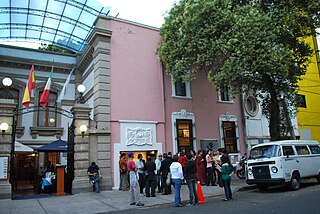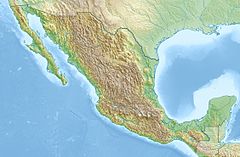
David Alfaro Siqueiros was a Mexican social realist painter, best known for his large murals in fresco. Along with Diego Rivera and José Clemente Orozco, he was one of the most famous of the "Mexican muralists". He was a member of the Mexican Communist Party, and a Stalinist and supporter of the Soviet Union who led an unsuccessful attempt to assassinate Leon Trotsky in May 1940.

Aguascalientes is the capital of the state of Aguascalientes and is its most populous city, with a metropolitan population of 1,225,432. It is one of the safest and most prosperous cities in Mexico. It is located in North-Central Mexico. It was part of the kingdom of Nueva Galicia. In 1835 Aguascalientes became the capital of the Free and Sovereign State of Aguascalientes. Aguascalientes has been called the cleanest city in Latin America. Aguascalientes is experiencing an ongoing social, economic, and aesthetic revitalization process. Aguascalientes has a population which includes Japanese, Koreans, Venezuelans, Spaniards, Canadians and Germans.
Wayne Thiebaud is an American painter known for his colorful works depicting commonplace objects—pies, lipsticks, paint cans, ice cream cones, pastries, and hot dogs—as well as for his landscapes and figure paintings. Thiebaud is associated with the pop art movement because of his interest in objects of mass culture, although his early works, executed during the fifties and sixties, slightly predate the works of the classic pop artists. Thiebaud uses heavy pigment and exaggerated colors to depict his subjects, and the well-defined shadows characteristic of advertisements are almost always included in his work.

The Baltimore Museum of Art (BMA) in Baltimore, Maryland, United States, is an art museum that was founded in 1914. The BMA's internationally renowned collection of 95,000 objects encompasses more than 1,000 works by Henri Matisse anchored by the Cone Collection of modern art, as well as one of the nation's finest holdings of prints, drawings, and photographs. The galleries currently showcase collections of art from Africa; works by established and emerging contemporary artists; European and American paintings, sculpture, and decorative arts; ancient Antioch mosaics; art from Asia, and textiles from around the world.

The Aguascalientes City Museum is located in the City of Aguascalientes, in the state of Aguascalientes Mexico, as the premier art museum in the city.
Venezuelan art has a long history. Initially dominated by religious motifs, art in Venezuela began emphasizing historical and heroic representations in the late 19th century, a move led by Martín Tovar y Tovar. Modernism took over in the 20th century. Notable Venezuelan artists include Arturo Michelena, Cristóbal Rojas, Armando Reverón, Manuel Cabré, the kinetic artists Jesús-Rafael Soto and Carlos Cruz-Diez, the Meta-realism artist Pajaro and Yucef Merhi.
José Raúl Anguiano Valadez was a notable Mexican painter of the 20th century, part of the “second generation” of Mexican muralists which continued the tradition of Diego Rivera, José Clemente Orozco and David Alfaro Siqueiros but experimented with it as well. Anguiano was born during the height of the Mexican Revolution, which would inspire a majority of his mural painting. He studied painting in his hometown of Guadalajara before moving to Mexico City to begin his career. His first major exhibition was held at the Palacio de Bellas Artes, at age 20. His works include over 100 individual and collective exhibitions with 50 murals, mostly in Mexico and the United States. As he continued his artistry with aspects of the Mexican muralism movement, he also experimented with other styles such as Cubism, Surrealism and Expressionism, with themes such as clowns and prostitutes. However, his most famous painting is “La espina” which depicts a Mayan woman digging a thorn out of her foot with a knife. His later works concentrated on depicting Mexico in vivid colors and traditional imagery.

Manuel Felguérez Barra was a Mexican abstract artist, part of the Generación de la Ruptura that broke with the muralist movement of Diego Rivera and others in the mid 20th century.

Salón de la Plástica Mexicana is an institution dedicated to the promotion of Mexican contemporary art. It was established in 1949 to expand the Mexican art market. Its first location was in historic center of the city but today it mostly operates out of a building in Colonia Roma. The institution is run by a membership of almost four hundred recognized artists and holds multiple exhibitions each year. Although it operates autonomously, it is part of the Instituto Nacional de Bellas Artes y Literatura.
Francisco Díaz de León was a Mexican graphic artist, notable for pioneering much of modern Mexican graphic arts. He spent his childhood around books and when he studied art in Mexico City, he specialized in engraving and illustration. He spent his career illustrating books, magazines and more, reviving techniques such as dry point and introducing new techniques and styles such as the use of color and linoleum printing. He was also a noted arts education, directing several schools including the Escuela Mexicana de las Artes del Libro, which he founded. He was a founding member of the Academia de Artes and a member of the Salón de la Plástica Mexicana. In 1969 he received the Premio Nacional de Artes for engraving.
Javier Arevalo was a contemporary Mexican artist whose work was the subject of many exhibitions, worldwide, including in Europe, Latin America, United States, Mexico and Japan. His influence was greatest in Mexico City, and Guadalajara, Jalisco. He also taught Art at the Palacio de Bellas Artes in Mexico City.
Nahum B. Zenil is a Mexican artist who often uses his own self-portrait as the principal model for a cultural critical interpretation of Mexico, especially concerning homosexuality and mestization. Zenil was born in 1947 in the state of Veracruz. In 1959, he enrolled at the Escuela Nacional de Maestros in Mexico City, from which he graduated in 1964. It was during this period in which Zenil became interested in painting. He later entered the Escuela Nacional de Pintura y Escultura in Mexico City in 1968. He is also one of the founding members of the Semana Cultural Gay, which occurs yearly at the Museo Universitario del Chopo. His art is often compared to that of Frida Kahlo, in which the self becomes the principal object of their paintings letting the viewer discover the artists as individuals as well as the broader social and cultural contexts in which they lived through the medium of self-portraiture.

Sandra Pani is a Mexican artist.

Carlomagno Pedro Martínez is a Mexican artist and artisan in “barro negro” ceramics from San Bartolo Coyotepec, in the Mexican state of Oaxaca. He comes from a family of potters in a town noted for the craft. He began molding figures as a child and received artistic training when he was 18. His work has been exhibited in Mexico, the U.S. and Europe and he has been recognized as an artist as well as an artisan. Today, he is also the director of the Museo Estatal de Arte Popular de Oaxaca (MEAPO) in his hometown. In 2014, Martínez was awarded Mexico's National Prize for Arts and Sciences
Leonel Maciel is a Mexican artist, member of the Salón de la Plástica Mexicana, from the coast of the state of Guerrero. Although from a rural area and farming family, he studied art at the Escuela Nacional de Pintura, Escultura y Grabado "La Esmeralda" and has traveled extensively in Europe and Asia, which has influenced his work. His art has changed styles from generally contains multiple elements and saturated colors.

Naomi Siegmann was an American artist who has developed her career in Mexico, and noted for the depiction of everyday objects outside their normal contexts. She began her career after she moved to Mexico with her family, learning to carve wood. She worked in this medium for about twenty years, before moving onto other materials, including recycled ones, in part due to her concerns for the environment. During her career, she had solo exhibits in Mexico and the United States, with participation in collective exhibits in these countries and Europe. She has been commissioned to create monumental works in Mexico and the United States. Her work has been recognized through a membership in the Salón de la Plástica Mexicana.
Yolanda Cabrera is a Mexican artist who was a graphic designer for twenty years before turning to the fine arts. Her work shows influence from her former profession along with the use of personal symbolism and experimentation in both materials and techniques. Cabrera’s work has been shown regularly in Mexico City and other parts of the country and has been recognized by the Salón de la Plástica Mexicana.
Flor Minor is a Mexican sculptor and graphic artist, known for bronze sculptures and graphic work that generally depict the male form. Her works often are based on the concept of balance or lack thereof. Minor has had individual exhibitions in notable venues in Mexico and abroad, and her work can be found in a number of public and private collections. She has been recognized in Mexico with membership in the Salón de la Plástica Mexicana.

The Longview Museum of Fine Arts (LMFA) is an art museum in downtown Longview, Texas. It was founded in 1958 by the Junior Service League of Longview. Since 1998, it has been on Tyler Street in downtown Longview.
Caleb Duarte Piñon is an American multidisciplinary artist who works with construction type materials, site-specific community performance, painting, and social sculpture and social practices.











